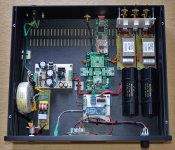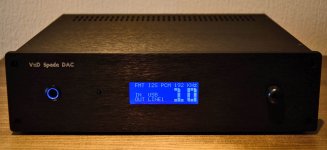Pedja Discrete diamond I/V
I use the Pedja discrete diamond I/V that is a bit similar to the AD844 on paper (current mirrors). I use that with the Philips TDA1541A S1 Crown. Yes, my voltage out dacs need no I/V and have none. The Saber might have an I/V however that OPPO player is unmodified. I am looking forward to trying the PCM1704 in the near future and possibly the PCM1794. Nice setup with all those valves. My builds for the most part have no negative feedback at least globally. I love the sound of tubes! Keep up the good work.
What I/V you write about? All DACs you mention are voltage out DACs and they need no I/V stage, frankly they works decently with no analogue stage at all, with one capacitor per channel alone.
My favourite to date is WM8804-PCM1794-passive I/V-tube gainstage DAC with Duelund CAST signal capacitors.
Rest of my setup are:
-EAD T-1000 CD transport (modified)
-Kondo KSL-M7 inspired handmade tube preamp
-modified ukrainian tube DHT PSE monoblocks based on 6B4G power triodes (excellent!)
-Merlin VSM Millenium speakers, but i'm working on to replace it by far better handmade ones.
As you can see, there is no single semiconductor in analogue signal path of my setup.
I use the Pedja discrete diamond I/V that is a bit similar to the AD844 on paper (current mirrors). I use that with the Philips TDA1541A S1 Crown. Yes, my voltage out dacs need no I/V and have none. The Saber might have an I/V however that OPPO player is unmodified. I am looking forward to trying the PCM1704 in the near future and possibly the PCM1794. Nice setup with all those valves. My builds for the most part have no negative feedback at least globally. I love the sound of tubes! Keep up the good work.
Nice... Which one is the favorite to your ears?
All TDA1541 are my fav. Everyone have their own sound.
As you can see, there is no single semiconductor in analogue signal path of my setup.
The DAC's a semiconductor and certainly has an analog stage. Besides which the internal digital processing has already added modulation noise. To have a purist approach (like your valve-based analog stages) you'd also want to minimize digital artifacts wouldn't you?
My latest DAC build is here - based on using hundreds of capacitors to implement passive shunts on the supplies. The DACs are TDA1387 (6 in a stack), passive I/V, Chebyshev LC filtering then the analog stages are AD815s, one per channel. There are hand-wound ferrite cored transformers in the base doing SE-unbal conversion. Battery power comes from 3 NiMH AA cells giving over 10hrs of listening.
Attachments
Last edited:
Tried TDA1541A-S1 also with good results in SQ.
AD1865 with CS5813 digital filter sounds very good, but replacing SM5813 with SM5842 gives significantly better SQ. Now it is comparable with my usual set PCM1796/CS8416. I'm rather settled with PCM1796 or 1794 as it reads HD formats and DSD also, so why bother with ancient chips?
Do You used in this compare, similar analogue tube output to this picture?
If I see properly, that power supply transformer is from LINN (it's linn logo?). Greetengs!
Attachments
A line pre-amp with built in DAC I made. still need to cut a top and program the micro-controller. has 3 coax and 2 fiber digital inputs (as well as 3 analog inputs) on the rear and one of each on the front. made the entire thing including the panels from scratch.
Attachments
Hello colleagues. From experience, it is desirable to apply the tube stage better options.Do You used in this compare, similar analogue tube output to this picture?
If I see properly, that power supply transformer is from LINN (it's linn logo?). Greetengs!
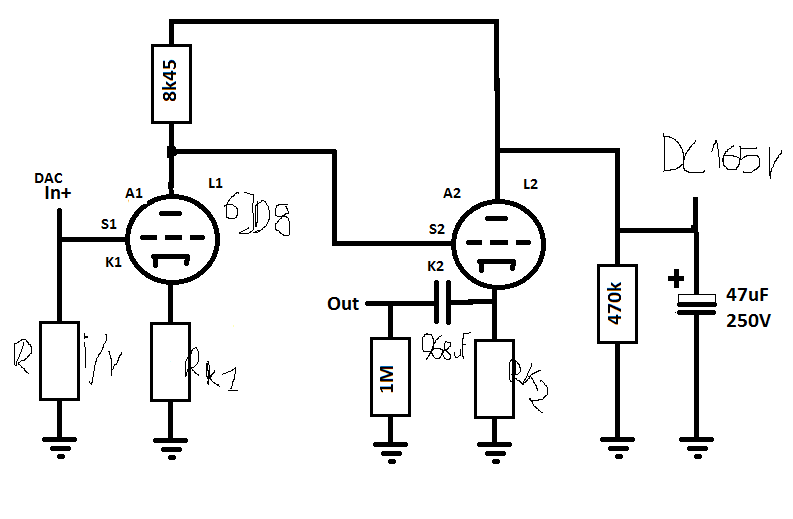
Attachments
Most recent DAC
Finally getting around to finishing some older projects. This one is a Sheldon Stokes 4398 DAC. Uses 8416 to sample rate convertor and outputs 192 KHz to a CS4398. Works well enough for my streaming and Bluray DTS -Master audio via Toslink. Lundahl transformer based filter for the output. Not on the same level as my 1541 based DAC's however it has it's place. I did install a Tent oscillator module and a dedicated clock power supply. The wood front is a piece of Brazilian Yellow heart with a simple finish. I have a Maple faceplate in the works when my wood working friend finds time.
Finally getting around to finishing some older projects. This one is a Sheldon Stokes 4398 DAC. Uses 8416 to sample rate convertor and outputs 192 KHz to a CS4398. Works well enough for my streaming and Bluray DTS -Master audio via Toslink. Lundahl transformer based filter for the output. Not on the same level as my 1541 based DAC's however it has it's place. I did install a Tent oscillator module and a dedicated clock power supply. The wood front is a piece of Brazilian Yellow heart with a simple finish. I have a Maple faceplate in the works when my wood working friend finds time.
Attachments
THETA 307 improved
307 new look !
307 new look !
An externally hosted image should be here but it was not working when we last tested it.
Pegasus II Ultra USB DAC
96kHz/24bit Async. USB on LPC1756 in slave mode
Optic decoupling from analog
MAX II CPLD as clock divider and I2S resync buffer
Two crystal oscillators for x44.1kHz and x48kHz frequencies
AD1853 as main DAC chip in RJ mode
AD8066 as I/U converter
LME49990 as LPF and output driver
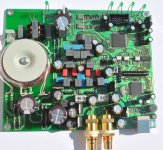
With headphone amplifier
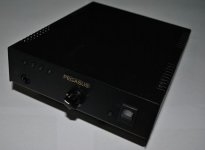
96kHz/24bit Async. USB on LPC1756 in slave mode
Optic decoupling from analog
MAX II CPLD as clock divider and I2S resync buffer
Two crystal oscillators for x44.1kHz and x48kHz frequencies
AD1853 as main DAC chip in RJ mode
AD8066 as I/U converter
LME49990 as LPF and output driver

With headphone amplifier

finished
clean and bright sound
I like it
[URL=http://imageshack.com/f/f0WMod5wj][IMGDEAD]http://imagizer.imageshack.us/v2/280x200q90/540/WMod5w.jpg[/IMGDEAD][/URL]
[URL=http://imageshack.com/f/f0WIgdhuj][IMGDEAD]http://imagizer.imageshack.us/v2/280x200q90/540/WIgdhu.jpg[/IMGDEAD][/URL]
clean and bright sound
I like it
[URL=http://imageshack.com/f/f0WMod5wj][IMGDEAD]http://imagizer.imageshack.us/v2/280x200q90/540/WMod5w.jpg[/IMGDEAD][/URL]
[URL=http://imageshack.com/f/f0WIgdhuj][IMGDEAD]http://imagizer.imageshack.us/v2/280x200q90/540/WIgdhu.jpg[/IMGDEAD][/URL]
HiHave you tried the PCM1704? So far to my ears my R2R dacs just sound better. I have a OPPO BDP83SE (Saber) and a CS4398 SRC Lundahls. I am starting a build late summer and will try a number of dacs.I could add the 1794 to list.
I am looking at a better DAC whre I am currently using CS4397 where I am going to take off the rh v+ and lh v+ either through the Lundahl or Sowters or even cap couple to see what this does.
Hi, this is my Buffalo III DAC.
The output BAL->SE is done à la Ciuffoli, with amorphous Lundahl transformers and Mundorf Supreme + teflon caps.
It has 3 selectable output channels.
It has two input channels: one Amanero async I2S USB and one S/PDIF.
The Amanero board is isolated by a Texas Instruments ISO7640 digital isolator (done the SMD board and soldering myself, it wasn't easy...)
The raw PSU is a nice and clean TIP142 emitter follower with TL431 voltage reference. The AC line is filtered (common and differential mode chokes).
The controller is a small Arduino Nano - it has enough I/O ports to control the DAC registers, select the input and output channels, control the LCD display, the IR remote control and the rotary encoder.
The firmware is based on Hifiduino, but it was completely rewritten and optimized. It has two display modes - a "normal", clutter free one, with essential information, and the full setup mode. The LCD backlight fades out after some time to a lower level and it fades in on user action.
The enclosure is a HiFi2000 Galaxy, very good quality. Front pannel milled by Schaeffer AG.
This is the best DAC I have ever heard, especially with the async I2S input.
The output BAL->SE is done à la Ciuffoli, with amorphous Lundahl transformers and Mundorf Supreme + teflon caps.
It has 3 selectable output channels.
It has two input channels: one Amanero async I2S USB and one S/PDIF.
The Amanero board is isolated by a Texas Instruments ISO7640 digital isolator (done the SMD board and soldering myself, it wasn't easy...)
The raw PSU is a nice and clean TIP142 emitter follower with TL431 voltage reference. The AC line is filtered (common and differential mode chokes).
The controller is a small Arduino Nano - it has enough I/O ports to control the DAC registers, select the input and output channels, control the LCD display, the IR remote control and the rotary encoder.
The firmware is based on Hifiduino, but it was completely rewritten and optimized. It has two display modes - a "normal", clutter free one, with essential information, and the full setup mode. The LCD backlight fades out after some time to a lower level and it fades in on user action.
The enclosure is a HiFi2000 Galaxy, very good quality. Front pannel milled by Schaeffer AG.
This is the best DAC I have ever heard, especially with the async I2S input.
Attachments
Hi, this is my Buffalo III DAC.
The output BAL->SE is done à la Ciuffoli, with amorphous Lundahl transformers and Mundorf Supreme + teflon caps.
It has 3 selectable output channels.
It has two input channels: one Amanero async I2S USB and one S/PDIF.
The Amanero board is isolated by a Texas Instruments ISO7640 digital isolator (done the SMD board and soldering myself, it wasn't easy...)
The raw PSU is a nice and clean TIP142 emitter follower with TL431 voltage reference. The AC line is filtered (common and differential mode chokes).
The controller is a small Arduino Nano - it has enough I/O ports to control the DAC registers, select the input and output channels, control the LCD display, the IR remote control and the rotary encoder.
The firmware is based on Hifiduino, but it was completely rewritten and optimized. It has two display modes - a "normal", clutter free one, with essential information, and the full setup mode. The LCD backlight fades out after some time to a lower level and it fades in on user action.
The enclosure is a HiFi2000 Galaxy, very good quality. Front pannel milled by Schaeffer AG.
This is the best DAC I have ever heard, especially with the async I2S input.
It looks avery well arranged bit of kit. Also it seems most use some sort of DAC output transformers especially Lundahls ammorphous cobalt or 80%nickel or other. Have you compared this with capacitor coupling for sound stage depth treble, mid, bass balance etc.
Like you Mark I agree not traffos with caps. The post above isa 3 way switchable for tranformer or cap out put or predumably op amp. So Vincent could perhaps tell us which he likes best and why. I wouild expect the cap to be the most transparent, but the Traffo depending on which one will be warmer with smooth but less detailed output. I expect the opamps are what op amps are, synthetic.If you're using output transformers why on earth are you also using output capacitors? I have a similar DAC that I built using Lundahl transformers. I have no analog stage and no output caps. Just the output of the DAC feeding the Lundahl transformers.
Mark
- Home
- Source & Line
- Digital Line Level
- DAC gallery
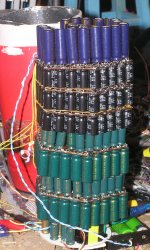
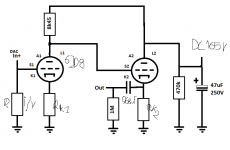
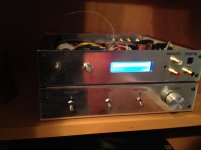
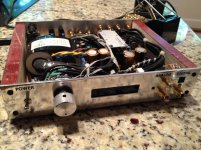
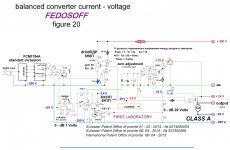
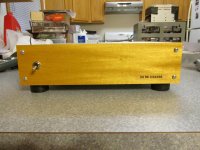
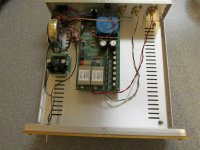
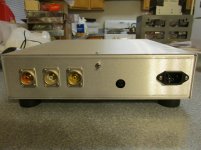
![URL]](/community/proxy.php?image=http%3A%2F%2F%5BURL%3Dhttp%3A%2F%2Fimageshack.com%2Ff%2Fipgkj9oVj%5D%5BIMGDEAD%5Dhttp%3A%2F%2Fimagizer.imageshack.us%2Fv2%2F280x200q90%2F673%2Fgkj9oV.jpg%5B%2FIMGDEAD%5D%5B%2FURL%5D&hash=9f3ebde3f3023902b1397c1bb9742aa3)
